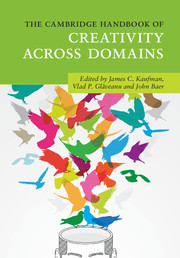Book contents
- The Cambridge Handbook of Creativity Across Domains
- The Cambridge Handbook of Creativity Across Domains
- Copyright page
- Dedication
- Contents
- Figures
- Tables
- Contributors
- Acknowledgments
- Part I Creativity and Domain
- Part II Creativity in the Traditional Arts
- 5 The Creativity of Literary Writing
- 6 Creativity in the Visual Arts
- 7 The Creation and Aesthetic Appreciation of Architecture
- 8 Photography and Creativity
- 9 The Constricted Muse
- 10 Musical Creativity
- 11 Dance
- Part III Creativity in the Sciences
- Part IV Creativity in Business
- Part V Newer Domains for Creativity Research
- Part VI Creativity in Everyday Life
- Part VII Conclusion
- Index
- References
5 - The Creativity of Literary Writing
from Part II - Creativity in the Traditional Arts
Published online by Cambridge University Press: 15 September 2017
- The Cambridge Handbook of Creativity Across Domains
- The Cambridge Handbook of Creativity Across Domains
- Copyright page
- Dedication
- Contents
- Figures
- Tables
- Contributors
- Acknowledgments
- Part I Creativity and Domain
- Part II Creativity in the Traditional Arts
- 5 The Creativity of Literary Writing
- 6 Creativity in the Visual Arts
- 7 The Creation and Aesthetic Appreciation of Architecture
- 8 Photography and Creativity
- 9 The Constricted Muse
- 10 Musical Creativity
- 11 Dance
- Part III Creativity in the Sciences
- Part IV Creativity in Business
- Part V Newer Domains for Creativity Research
- Part VI Creativity in Everyday Life
- Part VII Conclusion
- Index
- References
Summary
Literary writing involves externalization of mind onto paper or computer screen, and a process of guided exploration over a space of possibilities. Among the arts, this kind of writing may come closest in structure and content to everyday consciousness; this has enabled writers and readers to explore the workings of minds in interactions with others. Artistic writing is a kind of indirect communication in which the creativity of the writer invites the creativity of the reader. In personality, writers are higher in openness but more often depressed than other members of the population. Characteristics on which literary creativity is based make writers vulnerable to emotional disorders. With the exception of conversation, nothing may have been as important in understanding ourselves and others as works of creative writing.
- Type
- Chapter
- Information
- The Cambridge Handbook of Creativity across Domains , pp. 63 - 79Publisher: Cambridge University PressPrint publication year: 2017
References
- 6
- Cited by

